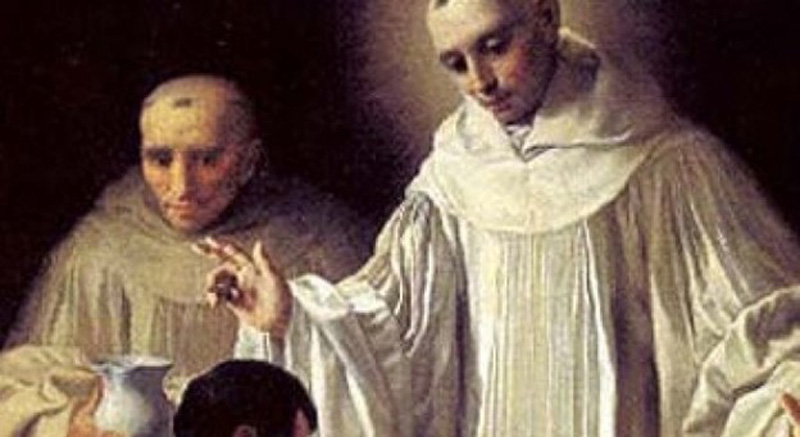(1018-1110)
Robert was born in Champagne, to Theodoric and Ermegarde, virtuous nobles who brought him up in learning and piety. At the age of 15, he became a Benedictine monk in the abbey of Montier-la-celle, where he made rapid progress and, though he was the youngest in that house, he was chosen prior, and sometime after made abbot of St. Michael de Tonnerre.
He found the monks of this place to be little disposed to follow his good intentions and efforts to establish regular discipline among them. He left them upon the invitation of some hermits who had no regular superior over them and asked him to fill that role. Robert moved with them into the forest of Molesme, where they built themselves little cells made of boughs of trees, and a small oratory in honor of the Holy Trinity, in 1075.
Soon, their poverty and the severity became known to several persons of quality in the neighborhood. They began to vie with one another in supplying the religious with necessaries, which introduced by degrees such a plenty that the hermits became lax and less fervent, so much, that Robert, having tried in vain all means to lead them to the regular observance of their profession, thought it proper for him to leave them.
Robert retired to a desert called Hauz, where certain religious men lived in great simplicity. Among this group of simple men, he was finally able to work for his subsistence, and employed as much of his time as possible in prayer and meditation. These religions men, seeing his edifying life, chose him for their abbot. Now the monks of Molesme realized they had not prospered since Robert’s absence. They obtained from the Pope and the bishop of Langres an order for his return to Molesme, on their promising that Robert should find them perfectly submissive to his directions.
Robert dutifully came back. But as their desire of his return was only grounded on temporal views, it produced no change in their conduct, even after a year. Some of them, however, seeing their lives were not conforming to the Benedictine Rule, which was daily read in their chapter, desired a reformation. The more zealous, seeing that it was impossible faithfully to comply with their duties in the company of those who would not be reformed, went to Robert, begging his leave to retire to some solitary place, where they might be able to perform what they had undertaken, and practice their vows.
Robert went with six of the most fervent of these monks to Lyons, to the archbishop Hugh, legate of the Holy See, who granted them letters patent to that effect; wherein he not only advised, but even encouraged them to leave Molesme, and to persist in their holy resolution of living up to the rigor of the rule of St. Benedict. Returning to Molesme, they were joined by the rest that were zealous. Twenty-one men went and settled in a place called Cistercium, or Citeaux, an uninhabited forest covered with woods and brambles, watered by a little river, at five leagues distance from Dijon, in the diocese of Challons. Here these religious men began to grub up the shrubs and roots, and built themselves cells of wood, with the consent of Walter, bishop of Challons, and of Renaud, viscount of Beaune, lords of the territory.
It was the 21st of March, the Feast of St. Benedict, in 1098, and was the origin of the Cistercian order. The archbishop of Lyons, being persuaded that they could not subsist there without the assistance of some powerful persons, wrote in their favor to Eudo, duke of Burgundy. That prince, at his own cost, finished the building of the monastery they had begun, furnished them for a long time with all necessaries, and gave them much land and cattle.
The bishop of Challons invested Robert with the office of abbot, thus elevating the new monastery into an abbey. The first rule established by St. Robert, at Citeaux, allotted the monks four hours every night for sleep, and four for singing the divine praises in the choir: four hours were assigned on working days for manual labor in the morning, after which the monks read till Noon: their diet was roots and herbs.
Once again, in the following year (1099), the monks of Molesme sent deputies to Rome to solicit an order for their abbot St. Robert’s return to Molesme, alleging that religious observance had suffered greatly by his absence; and that both the prosperity of their house, and the security of their souls depended on his presence. They assured his Holiness that they would use their best efforts to give him no further reason to complain about them. Urban II therefore wrote to the archbishop of Lyons, to procure St. Robert’s return to Molesme if it could be conveniently arranged. The legate sent his orders to that effect, and Robert immediately obeyed, remitting his pastoral staff for Citeaux to the bishop of Challons, who absolved him from the promise of obedience he had made him. He was installed anew by the bishop of Langres, abbot of Molesme, which he governed till his happy death.
Adapted by A.J. Valentini from: St. Robert, Abbot of Molesme, Founder of The Cistercians. (n.d.). Sensus Fidelium. Retrieved April 6, 2021, from https://sensusfidelium.us/the-lives-of-the-fathers-martyrs-and-other-principal-saints/april/st-robert-abbot-of-molesme-founder-of-the-cistercians/
